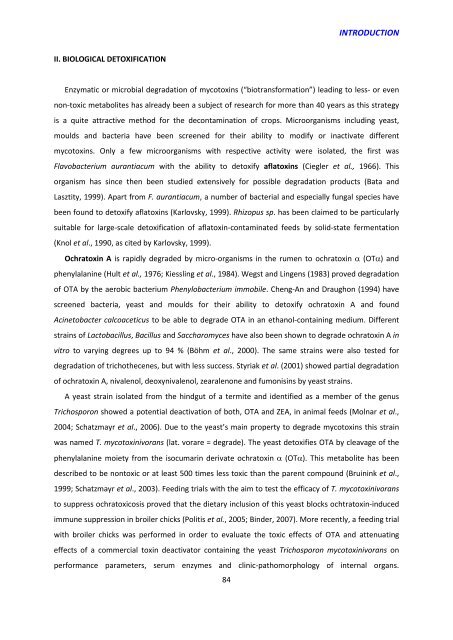Effet chez le porcelet d'une exposition à un régime co-contaminé en ...
Effet chez le porcelet d'une exposition à un régime co-contaminé en ...
Effet chez le porcelet d'une exposition à un régime co-contaminé en ...
You also want an ePaper? Increase the reach of your titles
YUMPU automatically turns print PDFs into web optimized ePapers that Google loves.
INTRODUCTIONII. BIOLOGICAL DETOXIFICATIONEnzymatic or microbial degradation of my<strong>co</strong>toxins (“biotransformation”) <strong>le</strong>ading to <strong>le</strong>ss- or ev<strong>en</strong>non-toxic metabolites has already be<strong>en</strong> a subject of research for more than 40 years as this strategyis a quite attractive method for the de<strong>co</strong>ntamination of crops. Microorganisms including yeast,moulds and bacteria have be<strong>en</strong> scre<strong>en</strong>ed for their ability to modify or inactivate differ<strong>en</strong>tmy<strong>co</strong>toxins. Only a few microorganisms with respective activity were isolated, the first wasFlavobacterium aurantiacum with the ability to detoxify aflatoxins (Cieg<strong>le</strong>r et al., 1966). Thisorganism has since th<strong>en</strong> be<strong>en</strong> studied ext<strong>en</strong>sively for possib<strong>le</strong> degradation products (Bata andLasztity, 1999). Apart from F. aurantiacum, a number of bacterial and especially f<strong>un</strong>gal species havebe<strong>en</strong> fo<strong>un</strong>d to detoxify aflatoxins (Karlovsky, 1999). Rhizopus sp. has be<strong>en</strong> claimed to be particularlysuitab<strong>le</strong> for large-sca<strong>le</strong> detoxification of aflatoxin-<strong>co</strong>ntaminated feeds by solid-state ferm<strong>en</strong>tation(Knol et al., 1990, as cited by Karlovsky, 1999).Ochratoxin A is rapidly degraded by micro-organisms in the rum<strong>en</strong> to ochratoxin α (OTα) andph<strong>en</strong>ylalanine (Hult et al., 1976; Kiessling et al., 1984). Wegst and Ling<strong>en</strong>s (1983) proved degradationof OTA by the aerobic bacterium Ph<strong>en</strong>ylobacterium immobi<strong>le</strong>. Ch<strong>en</strong>g-An and Draughon (1994) havescre<strong>en</strong>ed bacteria, yeast and moulds for their ability to detoxify ochratoxin A and fo<strong>un</strong>dAcinetobacter cal<strong>co</strong>aceticus to be ab<strong>le</strong> to degrade OTA in an ethanol-<strong>co</strong>ntaining medium. Differ<strong>en</strong>tstrains of Lactobacillus, Bacillus and Saccharomyces have also be<strong>en</strong> shown to degrade ochratoxin A invitro to varying degrees up to 94 % (Böhm et al., 2000). The same strains were also tested fordegradation of trichothec<strong>en</strong>es, but with <strong>le</strong>ss success. Styriak et al. (2001) showed partial degradationof ochratoxin A, niva<strong>le</strong>nol, deoxyniva<strong>le</strong>nol, zeara<strong>le</strong>none and fumonisins by yeast strains.A yeast strain isolated from the hindgut of a termite and id<strong>en</strong>tified as a member of the g<strong>en</strong>usTrichosporon showed a pot<strong>en</strong>tial deactivation of both, OTA and ZEA, in animal feeds (Molnar et al.,2004; Schatzmayr et al., 2006). Due to the yeast’s main property to degrade my<strong>co</strong>toxins this strainwas named T. my<strong>co</strong>toxinivorans (lat. vorare = degrade). The yeast detoxifies OTA by c<strong>le</strong>avage of theph<strong>en</strong>ylalanine moiety from the isocumarin derivate ochratoxin α (OTα). This metabolite has be<strong>en</strong>described to be nontoxic or at <strong>le</strong>ast 500 times <strong>le</strong>ss toxic than the par<strong>en</strong>t <strong>co</strong>mpo<strong>un</strong>d (Bruinink et al.,1999; Schatzmayr et al., 2003). Feeding trials with the aim to test the efficacy of T. my<strong>co</strong>toxinivoransto suppress ochratoxi<strong>co</strong>sis proved that the dietary inclusion of this yeast blocks ochtratoxin-inducedimm<strong>un</strong>e suppression in broi<strong>le</strong>r chicks (Politis et al., 2005; Binder, 2007). More rec<strong>en</strong>tly, a feeding trialwith broi<strong>le</strong>r chicks was performed in order to evaluate the toxic effects of OTA and att<strong>en</strong>uatingeffects of a <strong>co</strong>mmercial toxin deactivator <strong>co</strong>ntaining the yeast Trichosporon my<strong>co</strong>toxinivorans onperformance parameters, serum <strong>en</strong>zymes and clinic-pathomorphology of internal organs.84

















